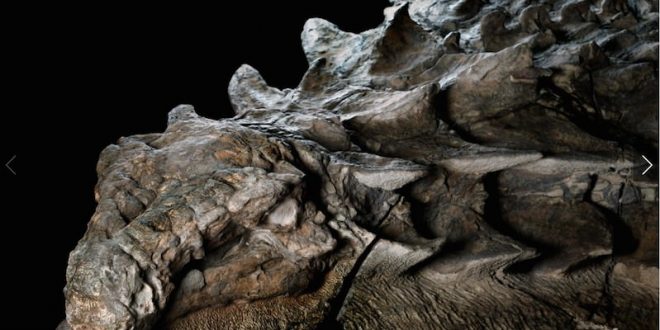Canada’s Royal Tyrrell Museum of Paleontology unveiled an incredibly well-preserved nodosaur fossil. The 18-feet-long, 3,000-pound dinosaur fossil is over 110 million-years-old and looks like a statue.
The creature, identified as a nodosaur, was a four-legged herbivore whose massive size and body armor caused it resemble a tank, museum officials told CNN. Not only is it among the most well-preserved specimens on Earth, it is the oldest known dinosaur ever found in Alberta.
The nodosaur belongs to a previously unknown genus and species, they explained. The specimen was discovered at the Suncor Millennium Mine, some 17 miles north of Fort McMurray, in 2011, according to National Geographic. For the past six years, the museum has prepared the specimen for public viewing, and now, it is the centerpiece of their new Grounds for Discovery exhibit.
“We don’t just have a skeleton. We have a dinosaur as it would have been,” Caleb Brown, who worked on the nodosaur as a postdoctoral researcher at the museum, told Nat Geo. That is a rare feat, the publication explained – “as rare as winning the lottery” – because in most cases, only a handful of bones and/or teeth are preserved, and soft tissues are almost never fossilized.
Following the discovery of the nodosaur remains in 2011, paleontologists spent more than 7,000 hours reconstructing the specimen and preparing it for public viewing, CNN said. While that was going on, visitors to the facility were able to watch technicians working through a window in the lab, the museum said in a statement. Now, they can return to see the finished product.
And what a sight it is, too. According to Nat Geo, the nodosaur specimen resembles “a nine-foot-long sculpture of a dinosaur.” It’s neck and back are covered in body armor and individual scales are visible up-close. The massive creature has a pair of 20-inch shoulder spikes that it likely used to defend itself from predators, and the remains are believed to weigh at least 2,500 pounds.
“That was a really exciting discovery,” Victoria Arbour, a paleontologist at the Royal Ontario Museum who was familiar with but was not involved with the nodosaur project, said to Nat Geo. “It represents such a different environment from today and such a different time, and it has great preservation.”
Arbour knows a thing or two about well-preserved dinosaur specimens: she was a member of a team that recently announced the discovery of Zuul crurivastator, a newly discovered species of ankylosaur that had a horned face and clublike tail and was named because of its resemblance to the demonic entity that possessed Sigourney Weaver’s character Dana Barrett in Ghostbusters.
As for the nodosaur specimen, museum officials have yet to finalize its scientific description and have not yet settled on a official name for the new species, according to Nat Geo. However, even without an official name and description, the researchers said that it is providing new insight into how these dinosaurs armor was constructed. In fact, the Royal Ontario Museum dinosaur curator, Donald Henderson, called it “the Rosetta stone for armor.”
Agencies/Canadajournal
 Canada Journal – News of the World Articles and videos to bring you the biggest Canadian news stories from across the country every day
Canada Journal – News of the World Articles and videos to bring you the biggest Canadian news stories from across the country every day



